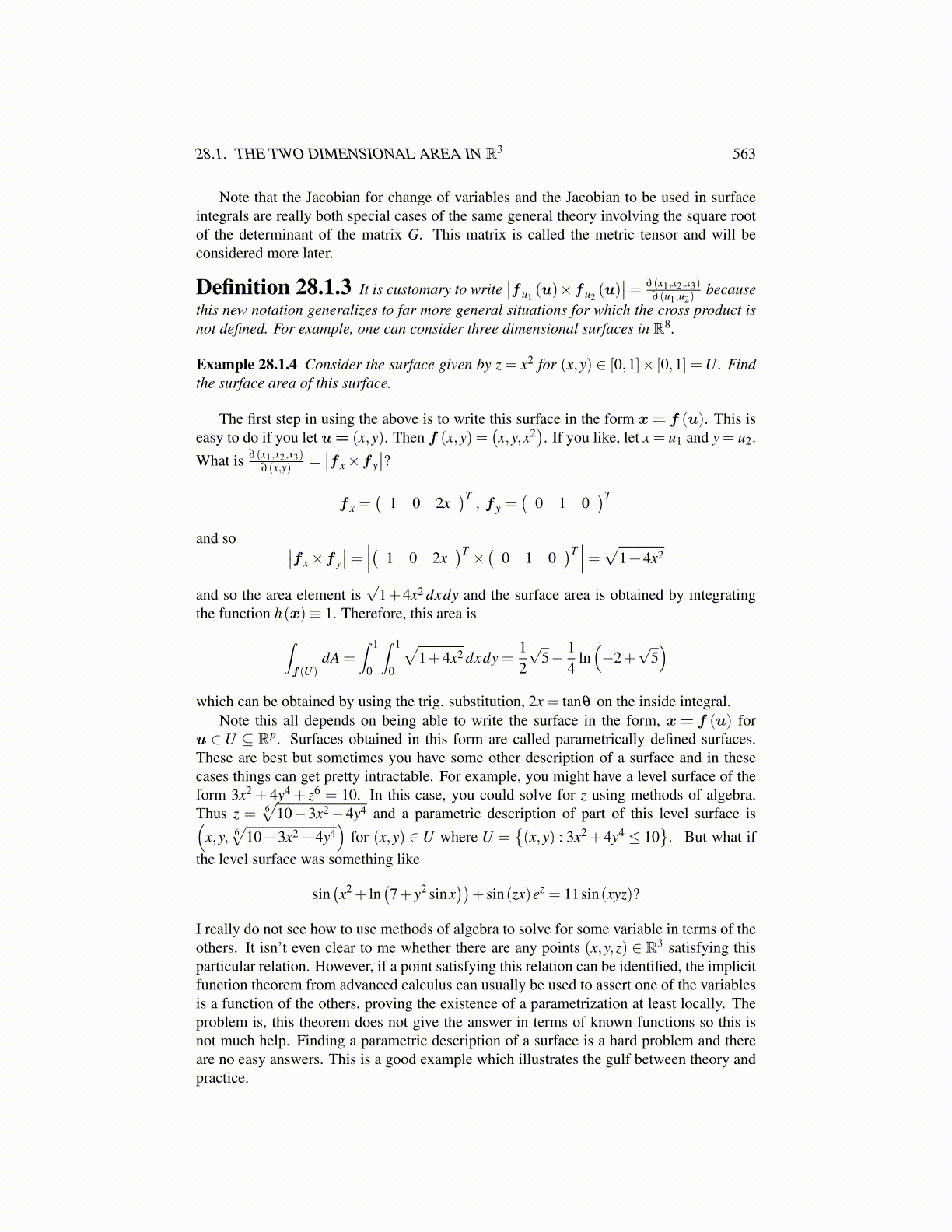
28.4. PIECEWISE DEFINED SURFACES 563
28.4 Piecewise Defined SurfacesAs with curves, you might piece together surfaces. In this section is considered what hap-pens on the place where the two surfaces intersect. First of all, we really don’t know how tofind the Riemann integral over arbitrary regions. We need to have the region be cylindricalin either the u or the v direction. That is, u ∈ [a,b] and for each u, the variable v is betweenT (u) and B(u). Alternatively, v ∈ [c,d] and for each v, the variable u is between L(v) andR(v) where L(v)≤ R(v). So what is meant by a piecewise smooth surface? Let
S ≡ S1 ∪S2 ∪·· ·∪Sm
where Sk ≡ rk (Dk) where Dk is one of the special regions just described and rk is one toone and C1 on an open set Uk ⊇ Dk such that ru × rv ̸= 0. Then we assume that eitherSk ∩S j = /0 or their intersection is rk (lk) = r j (l j) where lk, l j are one of the four edges ofDk and D j respectively. For example, say
Dk = {u ∈ [a,b] ,v ∈ [B(u) ,T (u)]}
and say lk is the top edge of Dk,{(u,T (u)) : u ∈ [a,b]}. Then from the definition, if f isdefined on S, and is 0 off Sk ∩S j,∫
Sf dS =
∫ b
a
∫ T (u)
T (u)f (u,v) |rku ×rkv|dvdu = 0
Other situations are exactly similar. The point is, when you have a surface which is de-fined piecewise as just described, you don’t need to bother with the curves of intersectionbecause the two dimensional iterated integral will be zero on these curves. The term forthis situation in the context of the Lebesgue integral is that the curve has measure zero. Inexamples of interest, the situation is usually that surfaces intersect in sets of measure zeroand so as far as the integral is concerned, these intersections are irrelevant.
28.5 Flux IntegralsThese will be important in the next chapter. The idea is this. You have a surface S and afield of unit normal vectors n on S. That is, for each point of S there exists a unit normalexcept for finitely many curves of measure zero. There is also a vector field F and youwant to find
∫SF ·ndS. There is really nothing new here. You just need to compute the
function F ·n and then integrate it over the surface. Here is an example.
Example 28.5.1 Let F (x,y,z) = (x,x+ z,y) and let S be the hemisphere x2 + y2 + z2 =4,z≥ 0. Let n be the unit normal to S which has nonnegative z component. Find
∫SF ·ndS.
First find the function F ·n ≡ (x,x+ z,y) ·
=n︷ ︸︸ ︷(x,y,z)
12= 1
2 x2 + 12 (x+ z)y + 1
2 yz. This
follows because the normal is of the form (2x,2y,2z) and then when you divide by itslength using the fact that x2 + y2 + z2 = 4, you obtain that n = (x,y,z) 1
2 as claimed. Nextit remains to choose a coordinate system for the surface and then to compute the integral.A parametrization is
x = 2sinφ cosθ , y = 2sinφ sinθ , z = 2cosφ